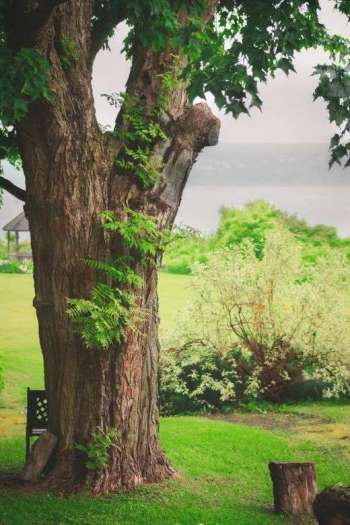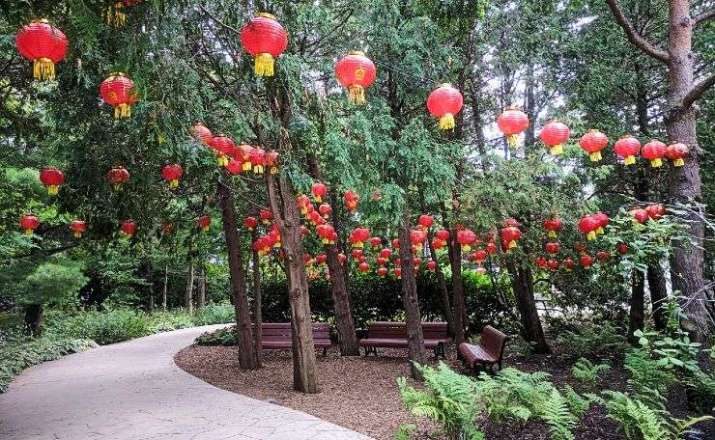This weekend I took part in an online retreat held by Extinction Rebellion Buddhists. The sessions were led by teachers from different traditions, united by our concerns about the climate and ecological emergency.
On Sunday afternoon, after some emotionally stirring Dharma talks and conversations, we were invited to spend more than an hour outside. We were told to find a spot that felt “right” and to just listen to what the world had to say to us.
Our middle-of-town temple has quite a large garden, tucked away from all the cars and people. It’s a mix of wild spaces, a vegetable patch, bamboo, flower beds, and mature trees. With a wet May followed by a gloriously sunny June, the plants have gone mad and there is lushness everywhere. I chose a shady spot underneath a crabapple tree, somewhere I wouldn’t usually sit, and I lay down on the grass with my two little dogs.
The next hour was extraordinarily luxurious. I lay quietly, looking up at the waving leaves and down at the moss woven into the grass. I wrote in my journal for a little while. I listened to the blackbird song and the quiet background hum of traffic. I took time out of my life of lists, of Getting Stuff Done, of stepping directly from one appointment to the next. My whole body breathed out.
I recently copied a list of advice from Eknath Easwaran’s book Take Your Time: The Wisdom of Slowing Down (Nilgiri Press 2012) onto a card, which I keep in my filofax. It begins with his directive for how to live a more spiritual life—just two words: SLOW DOWN. He goes on to flesh this out with eight points: give yourself more time, don’t crowd your day, ask what’s important, take time for relationships, take time for reflection, don’t let yourself get hurried, cultivate patience, and slow down your mind.
Of course, I already know these things are helpful to my wellbeing. I’ve been trying to apply this advice in my daily life for the past, well, several decades. I mostly understand what stops me from slowing down, including a compulsion to achieve as an antidote to parts of me that feel worthless, a fear of letting people down, and greediness for more experiences. I will probably always be prone to rushing and to diary-cramming. And it is also true that I have changed a lot. I see fewer psychotherapy clients these days and I say no more often. I book blank “retreat days” into my diary once a month. I feel more relaxed about relaxing.
My hour lying under the crab apple tree was a wonderful reminder of how crucial it is for me to set aside unstructured time and, if possible, to go outside. The Buddha didn’t speak a great deal about being outside because it was the ever-present backdrop to his life. He was born in the beautiful grove of Lumbini, became enlightened under a Bodhi tree—calling on the Earth goddess as witness—and died in a grove of Sal trees. I enjoy the beginnings of many sutras where it says which particular grove he’s residing in: the Banyan Tree Park, Jeta’s Grove, at Campa on a bank of the Gaggara Lotus Pond. Each of these places will have had their own characteristics and I imagine the Buddha becoming fond of particular trees and habitats as he returned year after year.
I would add another bullet point to Easwaran’s list: connect with nature. It feels especially crucial in these times of planetary distress that we take time to hang out with the Earth—to spend quality time with her—whether this is in a picturesque temple garden or a scraggy patch of wasteland between office blocks. Whether we are slowing down to admire a common blue butterfly or to regard the slow dance of clouds. Nature reminds me to slow down and slowing down connects me more closely with nature. Nature connects me to my spiritual life and my spiritual practice helps connect me to nature. Virtuous circles are everywhere!
It has been helpful to sit outside in my local town for an hour each day as a part of my year-long vigil, but I have missed unstructured time in nature, when I can slow down enough to hear what the Earth Goddess is saying to me. Yesterday, under the crabapple tree, she showed me the moss crowding out the grass and reminded me that my schedule is also getting a little full, and that when that happens everything starts to suffer. She reminded me how nice it is to spend time with the dogs without any pressure, just being together. She told me that rest, as well as being necessary, feels good!
Maybe when you’ve finished reading about my delicious time under the crabapple tree, you’ll go outside for five minutes and gaze at the sky. Maybe you’ll book some time with nature into your diary. Maybe you’ll be inspired by the Buddha and find a quiet spot in nature where you can meditate. I’m inviting you.
Related features from Buddhistdoor Global
The Healing Power of Nature and the Elements
Birdsong Dharma
Buddhism and Nature, and the Relationship with Human Suffering
One Foot on the Cushion and One in the Streets — Meditators for Climate Action
Coping with Fear, Anxiety, and Panic During the Pandemic
Touching the Earth: An Ecodharma Retreat
A Call for Meditation in Action on Climate Change
More from Dear Earth by Satya Robyn

















